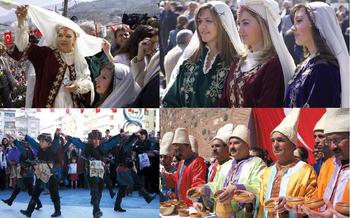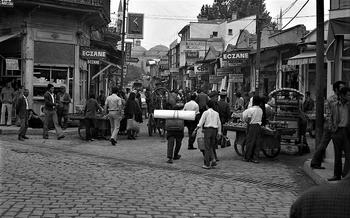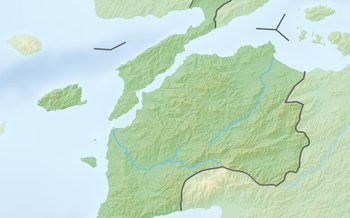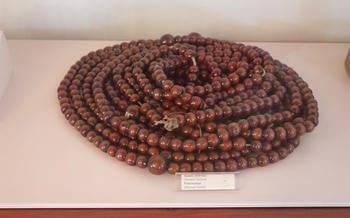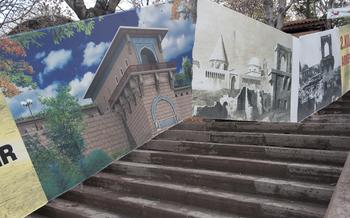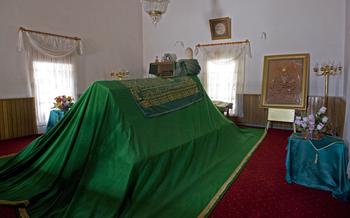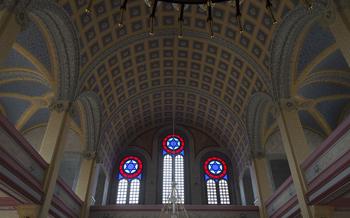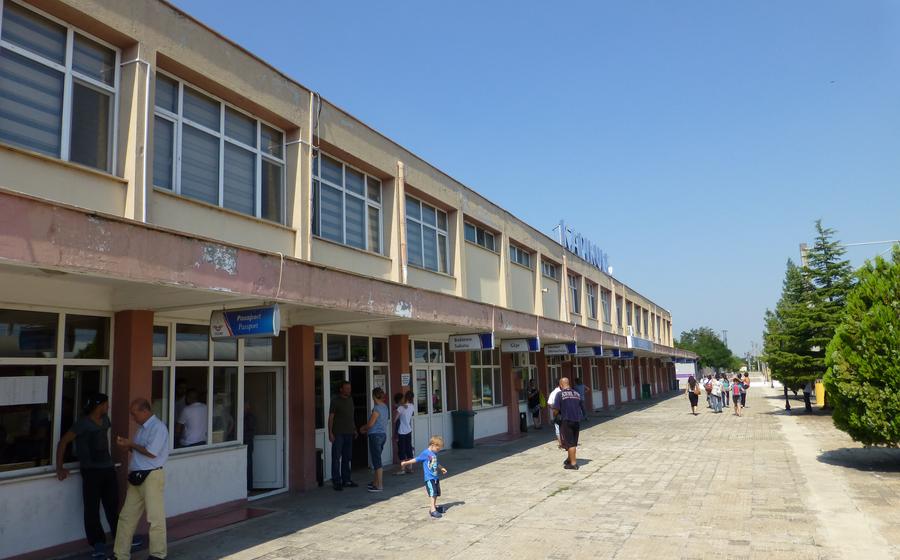
Sarayici Mevlevi Lodge
- Sarayici Mevlevi Lodge: A Spiritual Haven
- Location and Accessibility
- Hours of Operation and Admission Fees
- Guided Tours and Audio Guides
- Exploring the Lodge's Interior
- History of the Mevlevi Order
- Architecture and Design
- Mevlevi Music and Semah Ceremony
- Dervish Cells and Living Quarters
- Museum and Exhibitions
- Cultural Events and Programs
- Nearby Attractions and Places to Visit
- Local Cuisine and Restaurants
- Insider Tip: Hidden Gem
Sarayici Mevlevi Lodge: A Spiritual Haven
The Sarayici Mevlevi Lodge stands as a testament to the rich spiritual heritage of Turkey. Founded in the 15th century, this lodge was a sanctuary for the Mevlevi Order, a Sufi order renowned for its mystical practices and profound teachings. The lodge's significance extends far beyond its historical value, as it remains a living testament to the enduring legacy of Mevlana Rumi, the order's founder, and his teachings of love, tolerance, and spiritual enlightenment.
The lodge's architectural design embodies the essence of Mevlevi spirituality. Its octagonal shape symbolizes the eight gates of paradise, while the central dome represents the unity of all creation. The interior is adorned with intricate geometric patterns and calligraphy, each holding profound symbolic meanings. The lodge's main features include the semahane, where the Mevlevi dervishes perform their sacred semah ceremony, the meydan, a central courtyard for gatherings and rituals, and the hücreler, or individual cells where the dervishes lived and meditated.
Location and Accessibility
The Sarayici Mevlevi Lodge is situated at Sarayici Mahallesi Sokullu Paşa Caddesi No:66, Edirne, Turkey. It is conveniently located within the city center, making it easily accessible for visitors. To reach the lodge, one can take advantage of the well-connected public transportation system in Edirne. Several bus lines, including the Edirne Belediye Otobüsleri, stop within walking distance of the lodge. Alternatively, visitors can opt for a taxi or ride-sharing service, which are readily available in the city. For those traveling by car, limited parking spaces are available in the vicinity of the lodge, but it is advisable to plan accordingly, as the area can be crowded during peak tourist seasons. While exploring the Sarayici Mevlevi Lodge, visitors can also take advantage of its proximity to other notable attractions and landmarks in Edirne. The historic Edirne Grand Mosque, with its impressive architecture and religious significance, is just a short walk away. Additionally, the Edirne Archaeological and Ethnographical Museum, showcasing artifacts and exhibits from the region's rich history, is situated nearby. By combining a visit to the Sarayici Mevlevi Lodge with these other attractions, visitors can create a comprehensive itinerary that delves into the cultural heritage and diverse offerings of Edirne.
Hours of Operation and Admission Fees
The Sarayici Mevlevi Lodge welcomes visitors during specific hours to explore its historical and spiritual significance. The lodge is generally open to the public from 9:00 AM to 5:00 PM, seven days a week. However, it's advisable to check the official website or contact the lodge directly to confirm the exact hours of operation, as they may be subject to change during certain periods or holidays.
Admission to the Sarayici Mevlevi Lodge is subject to a modest entrance fee. The ticket prices are typically differentiated for adults, students, and children. Adult tickets usually range from 10 to 20 Turkish Lira (TL), while students and children may receive discounted rates. It's worth noting that group discounts or special offers may be available for larger groups or educational institutions.
To enhance the visitor experience, the lodge offers guided tours in various languages. These guided tours provide a more in-depth understanding of the lodge's history, architecture, and Mevlevi traditions. The cost of guided tours is typically separate from the entrance fee and can be arranged upon request or booked in advance through the lodge's website or designated tour operators.
For those who prefer a self-guided tour, audio guides or brochures are available in multiple languages, providing detailed information about the lodge's exhibits and features. These self-guided tours allow visitors to explore the lodge at their own pace and immerse themselves in the spiritual atmosphere of this sacred space.
Guided Tours and Audio Guides
The Sarayici Mevlevi Lodge offers guided tours in multiple languages, allowing visitors to delve deeper into the lodge's history, symbolism, and spiritual significance. These tours are led by knowledgeable guides who provide insights and anecdotes that enhance the overall experience.
Highlights of the guided tours include explorations of the lodge's interior spaces, such as the semahane (ritual hall), meydan (central courtyard), and hücreler (dervish cells). Guides explain the functions and symbolism associated with each area, shedding light on the Mevlevi Order's practices and beliefs.
The cost of guided tours varies depending on the group size and language preference. Advance booking is recommended to secure a spot, especially during peak tourist seasons. Self-guided tours are also an option, with audio guides or brochures available to provide information and context. These guides offer a more flexible and independent way to explore the lodge at one's own pace.
Exploring the Lodge's Interior
The Sarayici Mevlevi Lodge offers visitors a glimpse into the captivating world of the Mevlevi Order. Upon entering the lodge, one is immediately struck by its awe-inspiring architecture and intricate details. The focal point of the lodge is the semahane, a large, open hall where the Mevlevi dervishes performed their sacred semah ceremony. The meydan, a raised platform in the center of the semahane, represents the axis mundi, symbolizing the connection between heaven and earth.
The lodge also features hücreler, or private cells, where the dervishes resided and engaged in spiritual practices. These cells are furnished with basic necessities, reflecting the simplicity and austerity of the dervish lifestyle. Visitors can observe interactive multimedia presentations and displays that provide insights into Mevlevi rituals, history, and teachings.
It is important for visitors to maintain respectful behavior while exploring the lodge. This includes removing shoes before entering the semahane, speaking softly, and refraining from touching or disturbing any objects or artifacts. By observing these guidelines, visitors can contribute to the preservation of this sacred space and enhance their overall experience.
History of the Mevlevi Order
The Mevlevi Order, also known as the Whirling Dervishes, traces its origins to the teachings of the renowned Persian poet and mystic, Jalaluddin Rumi. In the 13th century, Rumi settled in Konya, Turkey, where he gathered a group of devoted followers who embraced his spiritual philosophy. These followers, known as dervishes, formed the foundation of the Mevlevi Order.
Under Rumi's guidance, the Mevlevi Order became a prominent spiritual and intellectual movement within the Islamic world. Rumi's emphasis on love, tolerance, and unity resonated with people from all walks of life, attracting a diverse group of followers. The order's teachings, based on Rumi's mystical poetry and Sufi principles, emphasized the importance of personal transformation and the pursuit of divine truth.
Throughout the Ottoman Empire, the Mevlevi Order gained widespread influence and recognition. Mevlevi dervishes established tekkes, or lodges, in various cities, including Istanbul, Bursa, and Edirne. These tekkes served as centers for spiritual gatherings, meditation, and the practice of Mevlevi rituals, including the iconic semah ceremony.
The Mevlevi Order played a significant role in shaping Turkish culture and spirituality. Its emphasis on music, poetry, and dance as forms of spiritual expression left a lasting impact on Turkish art and literature. The order's teachings on love, compassion, and universal brotherhood continue to inspire people worldwide, making it an enduring legacy in the realm of Islamic mysticism.
Architecture and Design
The Sarayici Mevlevi Lodge boasts remarkable architectural features that blend Islamic and Ottoman influences, creating a visually stunning masterpiece. Its unique octagonal shape symbolizes the eight gates of paradise in Islamic tradition, while the central dome represents the unity of God. The lodge's exterior is adorned with intricate geometric patterns and calligraphy, showcasing the artistry of Ottoman craftsmen. Inside, the lodge's spacious layout includes a central courtyard surrounded by two levels of balconies, creating a sense of harmony and symmetry. The use of natural light through strategically placed windows enhances the ethereal atmosphere, contributing to the lodge's spiritual significance. The meticulous restoration efforts undertaken in recent years have preserved the lodge's original architectural integrity, ensuring that it remains a testament to the rich cultural heritage of Turkey.
Mevlevi Music and Semah Ceremony
Music and chanting hold a profound significance in Mevlevi rituals, serving as a means to connect with the divine and express spiritual devotion. The semah ceremony, a sacred dance performed by Mevlevi dervishes, is a mesmerizing embodiment of this spiritual expression. During the semah, dervishes clad in long white robes gracefully twirl and sway to the rhythm of Mevlevi music, their movements symbolizing the rotation of the planets around the sun and the journey of the soul towards enlightenment.
The semah ceremony is not merely a dance performance; it is a deeply spiritual ritual that represents the dervishes' surrender to God and their striving for spiritual perfection. The whirling movements, accompanied by live music and chanting, create a trance-like state that allows the dervishes to transcend their physical existence and connect with the divine realm.
Visitors to the Sarayici Mevlevi Lodge have the opportunity to witness the semah ceremony during special events or performances. These events provide a glimpse into the rich spiritual traditions of the Mevlevi Order and offer a unique and awe-inspiring experience for those seeking a deeper understanding of Sufism and Islamic mysticism.
Dervish Cells and Living Quarters
Within the Sarayici Mevlevi Lodge, visitors can gain a glimpse into the living quarters and private cells of the Mevlevi dervishes. These spaces offer a unique opportunity to understand the simplicity and austerity that characterized the dervish lifestyle. The cells are small and sparsely furnished, reflecting the dervishes' commitment to material detachment and worldly renunciation.
Daily routines, practices, and rituals were strictly observed within these cells. Dervishes engaged in regular meditation, prayer, and remembrance of God. They also spent considerable time studying Islamic scriptures, poetry, and the teachings of Rumi. The cells provided a conducive environment for spiritual contemplation and self-purification.
Objects and furnishings in the cells hold symbolic meanings. Simple mats, blankets, and pillows served as bedding, emphasizing the dervishes' humble existence. Clothing was kept to a minimum, and personal possessions were few. The cells also featured niches or shelves where dervishes kept their copies of the Quran, prayer beads, and other sacred texts.
Exploring the dervish cells offers visitors a profound insight into the lives of these spiritual seekers. It highlights the dedication and discipline required to follow the Mevlevi path and serves as a reminder of the timeless values of simplicity, contentment, and devotion.
Museum and Exhibitions
Within the Sarayici Mevlevi Lodge, visitors can delve deeper into the history and traditions of the Mevlevi Order by exploring the on-site museum. This museum houses a collection of artifacts, documents, and exhibits that provide insights into the lives and practices of the Mevlevi dervishes.
The museum showcases a variety of objects, including musical instruments used in Mevlevi rituals, such as the ney (reed flute) and the kudüm (goblet drum). Visitors can also view historical manuscripts, calligraphy, and paintings that shed light on the Mevlevi Order's spiritual teachings and artistic expressions.
One of the highlights of the museum is a display of Mevlevi costumes and accessories. These garments, known as "sikke" and "taç," hold significant symbolism and represent the different ranks and stages of initiation within the order.
The museum at the Sarayici Mevlevi Lodge serves as an educational resource for those interested in Sufism, Islamic mysticism, and Turkish culture. It offers a unique opportunity to explore the rich heritage of the Mevlevi Order and gain a deeper understanding of their spiritual practices and contributions to Turkish history.
Cultural Events and Programs
The Sarayici Mevlevi Lodge is not just a historical site; it's also a vibrant cultural center that hosts a variety of events and programs throughout the year. These events provide visitors with an immersive experience of Mevlevi music, dance, and calligraphy, allowing them to delve deeper into the rich cultural heritage of the order.
Regularly scheduled events include concerts featuring traditional Turkish music and Mevlevi chants, as well as captivating performances of the semah ceremony by skilled dervishes. These performances offer a unique opportunity to witness the spiritual and artistic expression of the Mevlevi Order, transporting visitors to a realm of mysticism and devotion.
In addition to these performances, the lodge also organizes workshops, lectures, and exhibitions that explore various aspects of Mevlevi culture and history. Visitors can learn about the philosophy of Rumi, the practices of the dervishes, and the significance of Mevlevi music and dance. These educational programs provide a deeper understanding of the Mevlevi Order and its contributions to Islamic mysticism and Turkish culture.
To find out about upcoming events and programs, visitors can check the lodge's official website or inquire at the reception desk. By participating in these cultural activities, visitors can gain a deeper appreciation for the spiritual and artistic traditions of the Mevlevi Order, creating a lasting memory of their visit to the Sarayici Mevlevi Lodge.
Nearby Attractions and Places to Visit
Edirne, a city steeped in history and culture, offers a wealth of attractions beyond the Sarayici Mevlevi Lodge. To make the most of your visit, consider exploring nearby sites that complement the Mevlevi experience.
- Just a short walk away, discover the Selimiye Mosque, an architectural masterpiece commissioned by Sultan Selim II in the 16th century. Marvel at its soaring dome, intricate tilework, and elegant minarets.
- Immerse yourself in local history at the Edirne Museum, showcasing artifacts, exhibits, and interactive displays that bring the city's past to life. Learn about Edirne's role as the former capital of the Ottoman Empire and its rich cultural heritage.
- Take a leisurely stroll along the Meriç River, enjoying scenic views and the vibrant atmosphere of the riverside promenade. Cross over to Karaağaç Park, a tranquil oasis with lush greenery, walking paths, and playgrounds.
- Indulge in a traditional Turkish bath experience at the Edirne Hamamı, a centuries-old bathhouse that has been meticulously restored. Relax and rejuvenate in the steamy marble chambers, followed by a soothing massage.
- Explore the Bedesten, a covered market dating back to the Ottoman era. Browse through an array of local handicrafts, souvenirs, and regional delicacies, capturing the essence of Turkish bazaars.
Local Cuisine and Restaurants
Edirne's culinary scene is an enticing blend of Turkish and Balkan flavors, inviting visitors to savor the region's distinct gastronomic heritage. To delve into the local delights, venture beyond the main tourist areas and seek out the hidden gems where locals dine.
For an authentic taste of Edirne cuisine, try Kavala kurabiyesi, a buttery cookie flavored with mastic, a resinous spice that imparts a unique aroma. Edirne tava ciğeri, a dish of pan-fried liver, is another local specialty, best enjoyed with freshly baked bread and a sprinkle of lemon juice.
Vegetarians and vegans will find plenty of options in Edirne. The city's markets overflow with fresh produce, and many restaurants offer a variety of vegetable-based dishes. Try şevketi bostan, a wild thistle that is cooked with olive oil, garlic, and lemon, or mücver, a savory pancake made with grated zucchini and herbs.
To accompany your meal, sip on a glass of Edirne şırası, a sweet and tangy grape juice that is produced locally. For a truly immersive experience, visit the Edirne Kapalı Çarşı (Covered Market), a vibrant hub of activity where you can sample local delicacies and soak up the lively atmosphere.
Insider Tip: Hidden Gem
Beyond the main attractions, Edirne offers a hidden gem that provides a unique perspective on the Sarayici Mevlevi Lodge and its legacy. Located just a short walk from the lodge, the Rumi Cultural Center is a vibrant hub for contemporary expressions of Mevlevi culture.
This center showcases modern interpretations of Mevlevi music, dance, and art. Visitors can attend workshops, performances, and exhibitions that explore the fusion of traditional Sufi practices with contemporary artistic forms.
The Rumi Cultural Center provides a refreshing and dynamic take on Mevlevi heritage, allowing visitors to experience the living legacy of Rumi and the Mevlevi Order in a modern and engaging way. Don't miss the opportunity to visit this hidden gem for a truly immersive and transformative experience.
